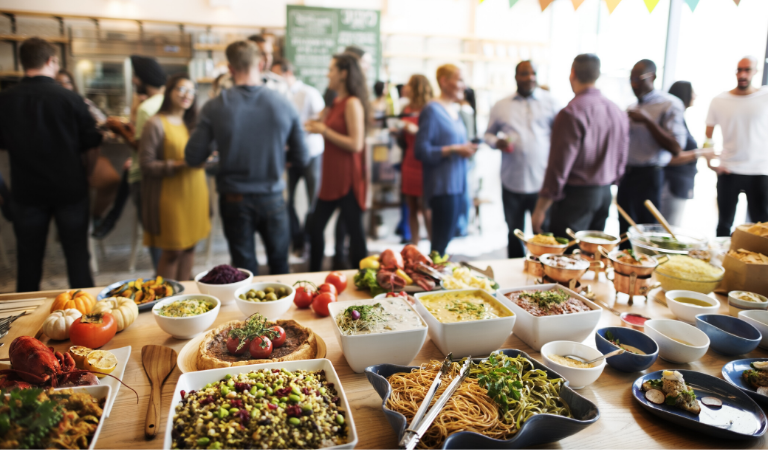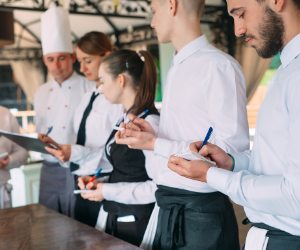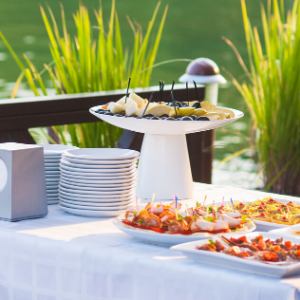One of the best things about being a caterer is the amount of interaction you get to have with customers.
Unlike restaurants where you're cooped up in a kitchen all day, you'll be able to get to know your
customers and work with them to create a menu and experience that fits their needs and the needs of
their guests. Sometimes you'll even get to cater outdoors at a beautiful botanical garden, or a gala in
a chic museum. However, as any experienced caterer will tell you, catering indoors and outdoors are two
vastly different concepts. That's why we have laid out the differences between these two food catering
styles and provided a few catering tips so you can be prepared no matter where your client's event takes
place.
Indoor Catering
Why Should You Cater Indoors?
Without a doubt, the prime environment for catering is indoors. If you've got the right equipment, you might even get to prepare and cook your food right in front of your customers, something they'll love! You'll also get to include more fresh food on the menu since you don't have to worry about food spoiling while traveling to your customer's venue. Plus, it's a lot easier to make any last-minute menu changes, especially if you're cooking on-premise, or at your own venue.
What Is Off-Premise Catering?
If you find yourself catering at an indoor venue other than your own, also known as off-premise catering, you'll want to find out if you have access to a kitchen that fits all of your needs. If that kitchen is not up to your standards, then you'll need to adjust accordingly. For example, the kitchen might be too small and there might not be enough room for your serving staff. In this case, you can direct your serving staff to only be in the kitchen when picking up or dropping off plates. This will prevent the kitchen from becoming overcrowded and reduces the chances of accidents.
Catering off-premise also means you'll have to travel from your establishment to your customer's venue. If the distance is too long, your food may not be the right temperature. That is why you should find out how long it will take to get there to help you create a timely schedule, determine what type of food to serve, and how to prep it. It will also help you pick what type of equipment you'll need, such as chafers and food pan carriers, to keep your food warm during transport and while serving.
What Is The Most Important Aspect Of Indoor Catering?
When it comes to indoor catering, coordination is key. Food preparation, servers, kitchen staff, and cleanup must be in a constant flow. Ideally, all of the factors that make up a catering service must function in such a way that your customers will barely notice that your staff is there. Detailed planning and communication with your employees will ensure you have a successful catering event.
Outdoor Catering
Is It Difficult To Cater An Outdoor Event?
For caterers, there are definitely more cons than pros when it comes to outdoor catering. Nevertheless, learning to pull off an outdoor catering gig is necessary for this field because you'll eventually come across customers that want to have their wedding reception at a beach or host a corporate catering event like a company picnic.
How Do I Get Started?
One of the first things you need to do when catering outside is reconnaissance. Go to where you'll be catering and check to see if there is enough space for staff to move around without bumping into each other and your equipment. This will help you determine how much food and equipment you can bring and it will make it easier for your staff to serve guests.
How Do I Handle Bad Weather At An Outdoor Event?
As every veteran caterer knows, the biggest obstacle will be the weather. When you're outside, anything can happen. You will be subject to mother nature, and you'll have to be ready for sudden weather changes such as rain, strong winds, and even hot weather. Luckily, renting out or buying a tent will certainly keep your clients from getting wet or too hot (and don't forget to get covers for your equipment too). You can also build your menu according to the season. For instance, you can serve snow cones on a hot summer day or hot chocolate on a winter holiday.
Will I Need Special Permits For An Outdoor Event?
In some instances, you'll have to cater in certain zones that require permits, so make sure to research and acquire all the permits required in your area. You should also make sure that you don't run out of supplies, the last thing you want is to be short of serving spoons or not have a backup heating element.
How Do I Keep Food Warm?
Chafers are a must-have when it comes to serving outdoors. One of the trickiest things to pull off in outdoor catering is keeping food fresh. The distance from your kitchen to your venue might be long or you might have to wait a long time until you get to serve customers. The right equipment will keep your food safe and at the ideal temperatures until the party begins.
Are There Any Ways To Make Outdoor Catering Easier?
This type of catering requires extensive planning and preparation, but don't worry, there are tricks! Here is a list of tips to help make outdoor catering an easy endeavor:
- Create a backup plan for inclement weather. As mentioned before, owning or renting out a tent is your best bet when it comes to protecting your guests and employees against rain and hot temperatures. You should also take the weather into consideration when creating your menu, for instance serving cool and refreshing drinks on a sunny day.
- Familiarize yourself with the venue. Visit the venue before the event takes place to check how much space you have to work with. This will help you figure out your set up and determine how many pieces of equipment and staff members you can bring.
- Check to make sure you have the required permits and licenses. In some instances, you'll find that you need permits and licenses at a certain location or to serve certain types of foods. For example, most areas require a liquor license for serving alcohol. Check with your local and state government to make sure you have all the documentation necessary for catering an event.
- Make a list of all the necessary equipment. The type of equipment you need will depend on the food you're planning to serve and your venue. You won't need a portable induction stovetop if you're planning on grilling and you'll need a power strip if your venue does not have enough outlets.
-
Keep bugs away from your food. Besides making sure all of your food is covered,
light up a citrus candle to keep those pesky insects at bay (citrus is a natural bug repellent). If
you have access to an indoor area, store your food inside for as long as possible and take it out
only when its time to serve.

- Make sure your venue is well lit. Sometimes you'll find yourself catering a dimly lit event that lasts well into the night. In these cases, you will need to bring your own lighting equipment to make sure you don't mix up condiments or sauces. Commercial heating lamps are great for lighting up your serving tables and keeping your food warm.
- Consider ways to keep food fresh. Colds foods such as veggie wraps and egg salads will last longer without the use of a heating element. You can also choose to barbeque so you can ensure your food will be hot off the grill by the time you serve.
Preparation Is Key
The meaning of catering might have changed over time but the original concept has always stayed the same. A caterer is someone who provides. It is arguably the most important part of any event and that's why preparation is the most essential aspect of catering. While outdoor catering might require more coordination and precise timing, you should always be ready for anything, indoors or outdoors.








